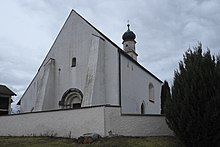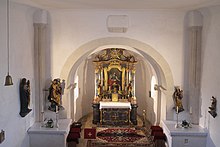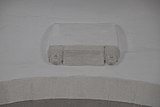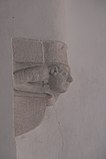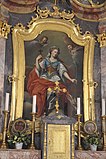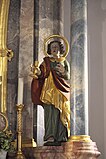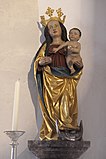St. Margaretha (Weißendorf, Oberdolling)
The Roman Catholic branch church St. Margaretha in Weißendorf , a district of the municipality Oberdolling in the Upper Bavarian district of Eichstätt , is a Romanesque hall building with an apse from the late 12th century. The church dedicated to St. Margaret of Antioch was consecrated to the two patron saints John the Baptist and the Evangelist John until 1559 . The church is one of the protected architectural monuments in Bavaria.
history
The Weißendorfer Church was built at the end of the 1180s or the beginning of the 1190s on an artificially piled earth wall on the site of a wooden previous building. It stood next to the noble seat of the builder and was surrounded by a fortification. The construction work was presumably carried out by the stonemason in the Regensburg Schottenkirche . In 1723, as part of the baroque style of the church, larger windows were installed in the nave and a roof turret with an onion dome was placed on the east gable .
architecture
portal
The Romanesque portal, the original entrance to the church, has been preserved on the west facade supported by two massive buttresses; another, smaller portal is bricked up. After the Gothic pointed arch portal was installed on the south side around 1350 , the west portal was walled up and later exposed again. The two pillars and the outer archivolt of the arched portal are decorated with braided ribbon , and lions are depicted on the fighters .
apse
The semicircular apse is made of limestone blocks from Vohburg quarries. Like the plinth of the nave, it is unplastered and the stone blocks of different sizes are carefully grouted. Under the roof of the apse approach a circular arc extending fries with 22 head consoles that are sculptured with animal and human heads. Above the apse of the apse, a human half-figure can be seen holding a book in her right hand. It could represent the Evangelist John and be a reference to the former St. John patronage .
inner space
The nave, originally planned with three aisles and three bays, is 11.10 meters long and 6.75 meters wide. In 1723, in the course of the baroque renovation of the church, today's flat ceiling was put in place of the former ribbed vault .
A wide chancel arch opens to the chancel . A cornice with two heads is walled in above the choir arch . On the south side, a crouching, small male figure with crossed arms and legs and finely worked facial features protrudes from the cornice under the choir arch. Under the ceiling at the height of the gallery you can see a console with a bust of a man, which probably originally supported the beginning of a vaulted yoke.
The stone gallery on the west side is supported by two columns that are decorated with figuratively sculpted cube capitals . On the capital of the southern pillar you can see a lamb with a cross staff, a lion with a human face, a panther with a fish tail behind its back, and the bust of a man who holds a book in his right hand and the left hand to the Has raised blessings. The capital of the northern column shows two intertwined fish, two birds or dragons, a lion biting its own paw, and a double animal with two bodies and the head of a cat. The corner bulbs of the bases are designed as rams 'heads on the southern column and eagles' heads on the northern column. The space under the gallery is divided into three bays and is covered by a groin vault. The stairs were not installed until 1886. Originally the gallery was only accessible from the outside via a connecting passage from the castle.
Furnishing
- The high altar was created around 1750 by Johann Georg Günther (1704–1783), the father of Ignaz Günther (1725–1775). The church patron saint, Saint Margaret, is depicted on the altarpiece . The two assistant figures are reminiscent of the original patrons, John the Baptist and the Evangelist John (who, however , is depicted with a chalice and snake, the attributes of the Apostle John ).
- The carved figure on the southern wall of the choir arch, a Madonna and Child from around 1500, comes from the workshop of Hans Sinninger.
- The figure of St. Christopher on the north wall of the choir arch was created by Bartholomäus Sedlmayr in 1694.
- The group of figures of Anna herself third on the north wall of the nave dates from around 1500 and was created by Georg Vischer.
- Like the high altar, the figure of St. Margaretha on the south wall is a work by Johann Georg Günther.
literature
- Georg Dehio : Handbook of the German art monuments. Bayern IV: Munich and Upper Bavaria . 2nd edition, Deutscher Kunstverlag, Munich 2002, ISBN 3-422-03010-7 , pp. 1268-1269.
- Gottfried Weber: The Romanesque in Upper Bavaria . Gondrom Verlag, Bindlach 1990, ISBN 3-8112-0703-2 , pp. 416-421.
Web links
- Romanesque churches around Ingolstadt: Weißendorf, St. Margaretha Stadtmuseum Ingolstadt
Individual evidence
- ↑ List of monuments for Oberdolling (PDF) at the Bavarian State Office for Monument Preservation, monument number D-1-76-150-8
Coordinates: 48 ° 50 ′ 58.5 " N , 11 ° 35 ′ 50.5" E

